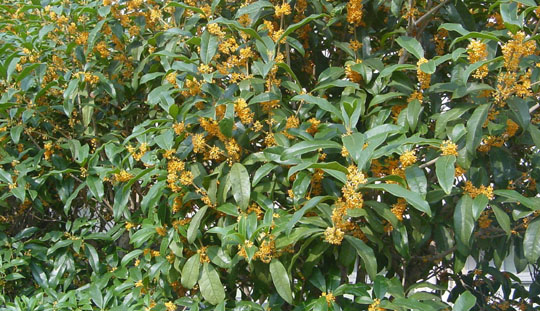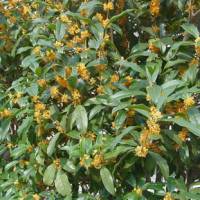Dear Alice,
The other day, while strolling in a park near my home, I overheard a group of middle-aged ladies. One of them said, "a, toire no nioi!" ("Oh, smells like a toilet!") and everyone laughed. I was puzzled, since we were nowhere near the public john, but then I realized they were talking about a nearby shrub! It had small orange flowers, and while its scent was powerful it was certainly not unpleasant. Can you tell me what the heck the shrub is and why it made the ladies think of toilets?
Helene S., Osaka
Dear Helene,
I know exactly what plant you're talking about. There are several in my neighborhood, and in full bloom right now. The blossoms are tiny but emit a powerful perfume that yanks you by the collar and pretty much demands you stop and take notice. The shrub, which can grow as large as a small tree, is native to China and is sold in English-speaking countries as fragrant tea olive (Osmanthus fragrans var. aurantiacus). Here in Japan it's widely planted and known as kinmokusei.
Putting the K-word into print pretty much guarantees me a gazillion Internet hits from anime fans. That's because Kinmokusei is also the home planet of the Sailor Starlights, a trio of characters in the "Sailor Moon" manga and anime series. Creator Naoko Takeuchi was obviously punning on the plant when she named their fictional home world, changing the last syllable into the kanji that forms the suffix "-sei" for "planet." (Normally the plant's name is written all in katakana.)
But to get back on topic, Japanese of a certain age associate kinmokusei with toilets because its powerful scent was once widely used in air fresheners. In fact, when I took your question to S.T. Corporation in Tokyo, a major manufacturer of air-care products, my contact pegged the age of the ladies in the park, even though I hadn't said a word about how old they were.
"Those women were almost certainly in their 40s to early 50s," Takeshi Tsunoda, a senior marketer with the company, told me. "That's the age group that most strongly associates kinmokusei with toilets, because there was a huge boom in kinmokusei products in the 1980s."
But S.T. Corporation, which markets Shoshuriki, Shoshu Potto and other popular brands in the air-care category, discontinued all kinmokusei-scented products in 2002. "We felt the link to toilets had perhaps become a liability and that it was better to make room for new scents, because consumers want novelty," Tsunoda explained. Kinmokusei also became less useful as the sanitary infrastructure in Japan improved.
It's hard to believe now, when even public restrooms are outfitted with costly commodes that wash and blow-dry your backside, but 30 years ago, sanitation standards in Japan weren't quite so squeaky clean. The old wa-shiki (Japanese-style) squatters — which I recently discovered have other interesting names such as kumitori-shiki toire (bail-out style toilet) and rakka-shiki benjo (drop-down-type lavatory) — had hard-to-clean surfaces that trapped the bacteria that cause odors. And most homes didn't have the automatic exhaust fans that are so prevalent now. If you were in Japan 20 or 30 years ago, you know what it was like to open a door and get completely skunked.
"Toilet conditions were definitely worse than they are now," Tsunoda agreed. "And the science and technology in air care hadn't yet advanced." Until about 1989, he explained, air fresheners simply masked bad smells by covering them up with strong scents such as kinmokusei and lemon. But modern products contain agents that can actually neutralize odor molecules in the air, so the role of scent in air fresheners has changed. "Now the scent is more for enjoyment, and that allows for milder smells."
About 80 percent of households in Japan use some kind of air-freshener product in the lavatory. "It's considered good etiquette," Tsunoda observed. "You've only got one toilet in the home, and everyone needs to use it, including guests. You don't know who will need it next or how soon, so you want to neutralize any unpleasant odors quickly and consistently."
The hot fragrance after kinmokusei was lavender, which at its peak in 2002 accounted for 30 percent of sales of air fresheners for the toilet and 20 percent of similar products for other rooms. But that lasting popularity may be its demise. "The problem we have now is that many people, particularly those in their 30s and 40s, have come to associate lavender with toilets," Tsunoda allowed. "It's still a strong seller for toilet air fresheners, although sales are tapering off, but some people are now reluctant to use lavender in other rooms of the house."
Right now, the trendy new scent in Japan is sekken (soap). I went into a minor lather when I heard that, because soap itself doesn't have a smell. In making "soap-scented" products, developers use the same types of fragrances used in popular brands of soap, drawing on scents with descriptors such as "powdery," "floral" and "sukkiri" (clean).
Also popular with consumers are various types of citrus scents, which make up about 20 percent of the market in toilet air fresheners, but lemon has given way to more fashionable scents like grapefruit and orange. There are seasonal scents in air fresheners too, including "Halloween," which is on shelves now. The limited-edition products for winter should be out a little later.
But the fastest growth seems to be in floral scents, fueled by novel combinations of fragrances such as those in S.T.'s new "bouquet" series. In the last few years, the floral category grew rapidly, suddenly accounting for about 20 percent of sales for general room fresheners and 11 percent of toilet air-care products.
Given this return to flower power, is there any chance of a kinmokusei come-back?
"I suppose it might be possible some day," Tsunoda ventured. "To be successful, it would need to appeal to older people who feel nostalgic for the smell of kinmokusei, while seeming fresh and novel to the younger generation who don't link kinmokusei with toilets."


















With your current subscription plan you can comment on stories. However, before writing your first comment, please create a display name in the Profile section of your subscriber account page.